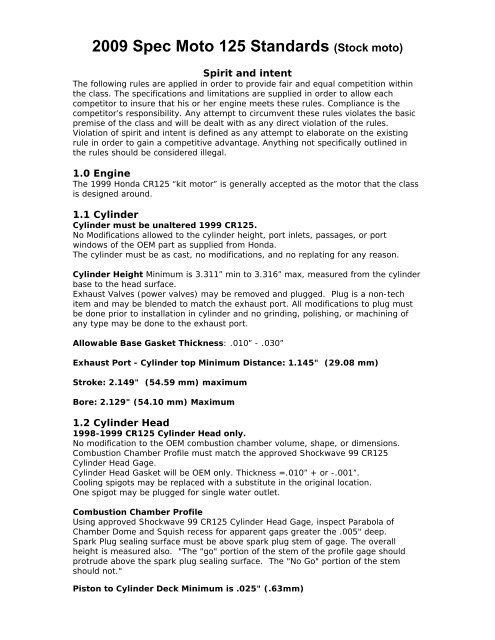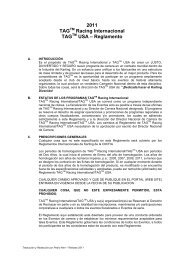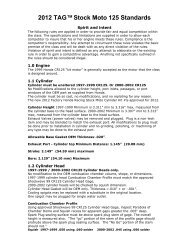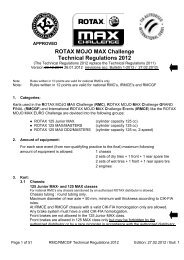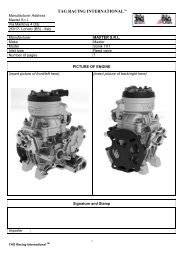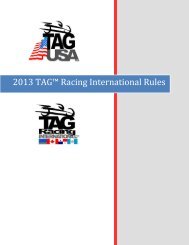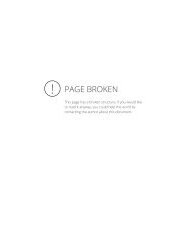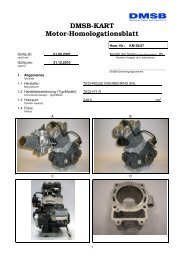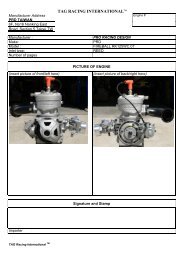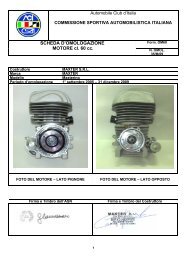2009 Spec Moto 125 Standards (Stock moto)
2009 Spec Moto 125 Standards (Stock moto)
2009 Spec Moto 125 Standards (Stock moto)
Create successful ePaper yourself
Turn your PDF publications into a flip-book with our unique Google optimized e-Paper software.
<strong>2009</strong> <strong>Spec</strong> <strong>Moto</strong> <strong>125</strong> <strong>Standards</strong> (<strong>Stock</strong> <strong>moto</strong>)<br />
Spirit and intent<br />
The following rules are applied in order to provide fair and equal competition within<br />
the class. The specifications and limitations are supplied in order to allow each<br />
competitor to insure that his or her engine meets these rules. Compliance is the<br />
competitor’s responsibility. Any attempt to circumvent these rules violates the basic<br />
premise of the class and will be dealt with as any direct violation of the rules.<br />
Violation of spirit and intent is defined as any attempt to elaborate on the existing<br />
rule in order to gain a competitive advantage. Anything not specifically outlined in<br />
the rules should be considered illegal.<br />
1.0 Engine<br />
The 1999 Honda CR<strong>125</strong> “kit <strong>moto</strong>r” is generally accepted as the <strong>moto</strong>r that the class<br />
is designed around.<br />
1.1 Cylinder<br />
Cylinder must be unaltered 1999 CR<strong>125</strong>.<br />
No Modifications allowed to the cylinder height, port inlets, passages, or port<br />
windows of the OEM part as supplied from Honda.<br />
The cylinder must be as cast, no modifications, and no replating for any reason.<br />
Cylinder Height Minimum is 3.311” min to 3.316” max, measured from the cylinder<br />
base to the head surface.<br />
Exhaust Valves (power valves) may be removed and plugged. Plug is a non-tech<br />
item and may be blended to match the exhaust port. All modifications to plug must<br />
be done prior to installation in cylinder and no grinding, polishing, or machining of<br />
any type may be done to the exhaust port.<br />
Allowable Base Gasket Thickness: .010” - .030”<br />
Exhaust Port - Cylinder top Minimum Distance: 1.145" (29.08 mm)<br />
Stroke: 2.149" (54.59 mm) maximum<br />
Bore: 2.129" (54.10 mm) Maximum<br />
1.2 Cylinder Head<br />
1998-1999 CR<strong>125</strong> Cylinder Head only.<br />
No modification to the OEM combustion chamber volume, shape, or dimensions.<br />
Combustion Chamber Profile must match the approved Shockwave 99 CR<strong>125</strong><br />
Cylinder Head Gage.<br />
Cylinder Head Gasket will be OEM only. Thickness =.010” + or -.001”.<br />
Cooling spigots may be replaced with a substitute in the original location.<br />
One spigot may be plugged for single water outlet.<br />
Combustion Chamber Profile<br />
Using approved Shockwave 99 CR<strong>125</strong> Cylinder Head Gage, inspect Parabola of<br />
Chamber Dome and Squish recess for apparent gaps greater the .005" deep.<br />
Spark Plug sealing surface must be above spark plug stem of gage. The overall<br />
height is measured also. "The "go" portion of the stem of the profile gage should<br />
protrude above the spark plug sealing surface. The "No Go" portion of the stem<br />
should not."<br />
Piston to Cylinder Deck Minimum is .025" (.63mm)
1.3 Crankcase<br />
Crankcase halves must be OEM.<br />
Internal Crankcase modifications are not allowed with the following exception. Minor<br />
grinding of casting flash is allowed but only to eliminate the possibility of flash<br />
breaking off and damaging the <strong>moto</strong>r.<br />
Kick Starter may be removed and plugged.<br />
Legacy Cases (fully modified cases) the use of legacy cases, i.e., may be utilized.<br />
The legacy cases may be used but must utilize the other stock components such as<br />
cylinder, head, ignition etc. All aftermarket crankshaft bearings must be steel<br />
material after market seals must be same size and diameter as OEM<br />
A weight penalty may be imposed (10 pounds). The use of Legacy cases will be<br />
approved through 2010. If the legacy cases are replaced, the new stock cases must<br />
comply with the “no internal or external modifications” rules.<br />
1.4 Crankshaft<br />
Crankshaft must be OEM Honda CR<strong>125</strong> any year. The crankshaft main bearing<br />
journals may be polished for slip fit of bearings.<br />
Precision alignment of crank is allowed.<br />
No material may be added or removed from Crank Wheels or Rod.<br />
No “heavy metal” balancing allowed.<br />
1.5 Connecting rod<br />
Connecting rod must be OEM with no lightening or polishing.<br />
Bearings, piston pin and cir-clips are direct replacement OEM only.<br />
1.6 Piston<br />
1999 OEM Flat Top design direct replacement OEM only.<br />
This piston has a window and cannot be replaced with non-window piston.<br />
Piston Ring Minimum Thickness: .038" (.96 mm) as measured with calipers.<br />
1.7 Bearings<br />
All crankshaft and rod bearings must be stock OEM without modifications.<br />
1.8 Gaskets and seals<br />
Gaskets are non-tech.<br />
Seals must be stock OEM without modifications and installed as manufactured.<br />
1.9 Clutch<br />
<strong>Stock</strong> OEM 1999 CR<strong>125</strong> Clutch Basket and Pressure Plate must be used.<br />
No modifications allowed to any component.<br />
All 7 Clutch disks and 6 Clutch Plates must be installed.<br />
Aftermarket replacement clutch discs, plates, springs and hardware parts are<br />
allowed.<br />
1.10 Transmission<br />
Transmission Bearings are to be stock OEM.<br />
Micro polishing of Gears is allowed.<br />
Five or six gears are allowed.<br />
Gears are per the 1994-96 ratios as follows;<br />
First - 14/33<br />
Second - 15/28<br />
Third - 19/29<br />
Fourth - 21/27<br />
Fifth - 23/26<br />
Sixth - 24/24
1.11 Water pump<br />
Water pump must be used as originally intended. No external or axle driven pumps<br />
allowed.<br />
2.0 Induction System<br />
2.1 Carburetor<br />
Approved carburetors are,<br />
Keihin PWM, Keihin PWK, Mikuni TMX38<br />
No modifications allowed. No polishing, grinding or machining allowed.<br />
Venturi Diameter may not exceed 38.6 mm in diameter measured from the first<br />
.450” of the Venturi diameter downstream from the slide. Round bore only<br />
Pump-around Carburetor Fuel Feed Systems are allowed.<br />
2.2 Fuel Pump<br />
Fuel Pump(s) must be driven by pulse pressure in the <strong>moto</strong>r. No Electronic Fuel<br />
Pumps. Dual Fuel Pumps for Pump around Carburetors allowed. Fuel Pump must be<br />
a separate component from the Carburetor.<br />
2.3 Carburetor Boot<br />
The stock 1999 CR<strong>125</strong> 30° Boot is recommended.<br />
The RS<strong>125</strong> Straight Boot or the RS<strong>125</strong> 5° boots are allowed For Seat Clearance<br />
Purposes. However, the Stuffer Lobes of the Straight Boot and the 5° boot must be<br />
cut off flush with mounting surface and may not extend into Reed cage.<br />
2.4 Reed cage and Reeds<br />
Reeds are open but must be single petal design. No dual stage reed petals Reed cage<br />
must be 1999 CR<strong>125</strong> 6-Petal Design.<br />
No material may be added or removed.<br />
Reed Stops must be 1999 CR<strong>125</strong>. Bending stops to fit into unaltered reed throat of<br />
crankcase is allowed.<br />
No removal of material from Reed Stops allowed.<br />
2.5 Air Filters and Air Boxes<br />
<strong>Moto</strong>r may be equipped with either Air Filter or Air box. Air Box Requirements may<br />
be imposed by Local Track regulations.<br />
3.0 Exhaust System<br />
3.1 Pipe/Expansion chamber<br />
The Pipe/Expansion chamber is restricted to the following,<br />
RLV 6800 series also marked as (RLV-R2)<br />
RLV-R4<br />
RCE T3<br />
The Pipe/Expansion chamber Maximum Circumference is 17-1/8” (440mm)<br />
measured at the drum/dwell section.<br />
Addition of exhaust gas temperature lead is legal, but hole must be plugged if<br />
exhaust temp lead is not used.<br />
External mounting brackets may be added.<br />
3.2 Silencer<br />
Silencer should be a minimum of 10" long by 2-1/2" in diameter. Tracks that have<br />
noise emission requirements shall provide any necessary supplemental rules for<br />
where noise abatement is required.
3.3 Exhaust Flange<br />
The exhaust flange is open but aftermarket headers may not alter the effective<br />
length of the exhaust system by more than plus or minus .050”.<br />
4.0 Ignition<br />
4.1 Coil<br />
Coil must be <strong>Stock</strong> 1999 Honda CR<strong>125</strong> Coil.<br />
4.2 CDI<br />
Capacitive Discharge Ignition (CDI) must be <strong>Stock</strong> 1999 Honda CR<strong>125</strong>.<br />
Denso Part Number 071000-1410 should be legible on Tag.<br />
4.2 Flywheel and stator<br />
Flywheel and stator must be <strong>Stock</strong> 1999 Honda CR<strong>125</strong> parts.<br />
No material may be removed from Flywheel.<br />
Flywheel Key may not be machined to offset timing.<br />
Stator may be mechanically advanced or retarded but must remain in a fixed<br />
position while running.<br />
Stator Plate may be slotted for adjustment.<br />
4.3 Spark Plug and Ignition Wires<br />
The spark plug manufacturer is open, but the plug must be commercially available<br />
and measure 18.5mm long by pitch M14 x 1.25. Exception: The spark plug washer<br />
may be removed to facilitate the use of a cylinder head temperature sensor and the<br />
gap of the electrode may be adjusted.<br />
Ignition Wires are non-tech.<br />
No additional components may be electrically connected to the CDI or Coil. Only an<br />
inductive RPM sensor may be used<br />
5.0 Ancillaries<br />
Studs, Bolts and washers are non-tech.
Technical inspection procedure and specifications<br />
1.0 Engine<br />
Cylinder Height Minimum: 3.311” min to 3.316” max., as cast, no modifications,<br />
and NO replating for any reason.<br />
Measure Base Surface to Head Surface with calipers.<br />
Port Inspection<br />
If Ports appear substantially different, the Tech Inspector should follow up with a<br />
close inspection for any evidence of grinding to modify the port sizes. Small<br />
differences in sizes make very little difference in performance gains. Any DQ actions<br />
should be based on obvious modification evidence.<br />
Exhaust Port - Cylinder top Minimum Distance: 1.145” (29.08 mm)<br />
Note 1: This measurement is taken from the top of the cylinder to the exhaust port<br />
opening. It is not intended to measure opening in relation to piston travel alone.<br />
Note 2: Exhaust Valves may be plugged. Plug is a non-tech item. Plugs may have<br />
blades removed or angled to blend flow into passage. This does not allow for<br />
blending of plug to port all modifications to plug must be done prior to installation in<br />
cylinder. In some cases the blades may appear to provide a false reading of depth -<br />
this is OK as long as inspection does not indicate any grinding. CR<strong>125</strong> Exhaust ports<br />
have a height that is controlled by the machining operation of the Exhaust valve and<br />
is very accurate in controlling port location.<br />
Insert Approved Port Height Check Gage (1.140" Step) tool into Cylinder in line with<br />
Exhaust Port Center. Inspect through Port - Gage end should not extend past Port<br />
Opening at edge. Check both ports at highest points.<br />
Combustion Chamber Profile<br />
Using approved Shockwave 99 CR<strong>125</strong> Cylinder Head Gage, inspect Parabola of<br />
Chamber Dome and Squish recess for apparent gaps greater the .005" deep.<br />
Competitor may clean off carbon build up with abrasive pad. Spark Plug sealing<br />
surface must be above spark plug stem of gage. The overall height is measured also.<br />
"The "go" portion of the stem of the profile gage should protrude above the spark<br />
plug sealing surface. The "No Go" portion of the stem should not."<br />
Cylinder Head Gasket thickness is .010” +or -.001”. OEM only.<br />
Measure thickness of Head Gasket with calipers<br />
Piston Deck Height<br />
Cylinder Deck Minimum is .025" (.63mm)<br />
Rotate flywheel to bring piston close, but not at, Top Dead Center. Set Depth Gage<br />
on Cylinder Deck with edge facing down over piston. Rotate piston to TDC and past.<br />
Piston impact with gage should not felt by inspector. Alternate method, measure<br />
depth at TDC with Depth Gage.<br />
Piston inspection and dimensions<br />
Flat Top design OEM Piston has window and cannot be replaced with non-window<br />
piston. Only direct 1999 OEM replacement allowed.<br />
Distance from Top of Piston Pin to top of Piston: .807” (20.5mm) plus or minus<br />
.0025”<br />
Slide piston pin out of piston with no more than 1/4" protruding.<br />
Measure depth from top of piston to top of piston pin with caliper slide.<br />
Piston Ring Minimum Thickness: .038" (.96 mm) as measured with calipers.
Stroke: 2.149” (54.59 mm) maximum<br />
Piston may rock on pin. Measure depths directly above pin. Measure Piston depth<br />
at TDC. Measure Piston depth at BDC. Subtract TDC from BDC to get the stroke.<br />
Bore: 2.129" (54.10 mm) Maximum<br />
Measure with Inside Micrometer.<br />
Allowable Base Gasket Thickness: .010” - .030”<br />
Measure Base Gaskets with a caliper<br />
2.0 Induction System<br />
Carburetor<br />
Max diameter 38.6 mm round bore only Approved carburetors are Keihin PWM,<br />
Keihin PWK, Mikuni TMX38<br />
No modifications to Carburetor No polishing or machining of air intake allowed<br />
Control point for measuring purposes is the first .450” of the Venturi diameter<br />
downstream from the slide. This .450” wide zone cannot exceed 38.6mm in<br />
diameter.<br />
Carburetor Boot<br />
The stock 1999 CR<strong>125</strong> 30° Boot is recommended. As this part is optimal from the<br />
factory and measurements very subjective, there are no other restrictions on it.<br />
For Seat Clearance Purposes, the RS<strong>125</strong> Straight Boot or the RS<strong>125</strong> 5° boots are<br />
allowed. As a handicap the Stuffer Lobes of the Straight Boot and the 5° boot must<br />
be cut off flush with mounting surface and may not extend into Reed cage.<br />
3.0 Exhaust System<br />
Pipe/Expansion chamber<br />
Measure largest diameter of the drum/ dwell section (between convergence and<br />
divergence cones) with a flexible tape measure. Pipes may have obstructions such<br />
as mounting flanges, metal tags, seams, or weldments in the way. It is the<br />
competitor’s obligation to assure there is an area where the circumference can be<br />
measured by tech.<br />
4.0 Ignition<br />
<strong>Stock</strong> 1999 Honda CR<strong>125</strong> Coil<br />
<strong>Stock</strong> 1999 Honda CR<strong>125</strong> Capacitive Discharge Ignition (CDI) System.<br />
Denso Part Number 071000-1410 should be legible on ID tag. CDI cannot be DQ'd<br />
over ID tag legibility. Sanctioning Org may take possession of CDI unit to test for<br />
illegal altering of the component. CDI Unit must be returned to owner or replaced<br />
with a new part within 30 days.<br />
CDI Grid Swap<br />
The Tech Steward shall have the option to collect CDI Units between heats and<br />
redistribute them at impound. This is at the Tech Steward/Promoters discretion.<br />
Flywheel and stator.<br />
<strong>Stock</strong> 1999 Honda CR<strong>125</strong><br />
No material may be removed from Flywheel. Flywheel Key may not be machined to<br />
offset timing. Stator may be mechanically advanced or retarded but must remain in<br />
a fixed position while running. Stator Plate may be slotted for adjustment.<br />
Spark Plug and Ignition Wires.<br />
The spark plug manufacturer is open, but the plug must be commercially available<br />
and measure 18.5mm long by pitch M14 x 1.25. Exception: The spark plug washer<br />
may be removed to facilitate the use of a cylinder head temperature sensor and the<br />
gap of the electrode may be adjusted. Non-tech. No additional components may be<br />
electrically connected to the CDI or Coil. Only an inductive RPM sensor may be used.


